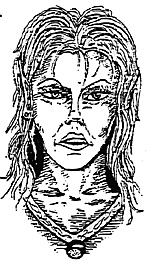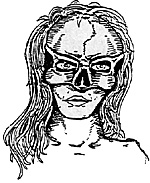 She's ugly. She's magic. She knows a lot more about you than you know yourself
She's a hag, and she and her sisters have populated the folklore and literature of many cultures and time periods.
She's ugly. She's magic. She knows a lot more about you than you know yourself
She's a hag, and she and her sisters have populated the folklore and literature of many cultures and time periods.
Some of the earliest appearances of hags are related through the mythologies of ancient civilizations, such as the Greeks and Romans. The Fates are a kind of prototype for the hags who appear later; they are supernatural women whose knowledge of a hero's destiny is often revealed through obscure prophecy and visions. In Greek myth, there are three Fates: Klotho, who spins the thread of life, Atropos, who weaves the fabric of a person's deeds, and Lachesis, who determines the length of the thread, and therefore the length of life. They are ugly and cruel, and also blind to the physical world around them. You can catch a glimpse of these three in movies about ancient lore such as Clash of the Titans or Disney's Hercules, and for a Renaissance version of the trio, see the witches in Shakespeare's Macbeth.
Individual hags in folklore and literature are just as common as versions of the Fates, though. For example, in the tale entitled "The Woman's Quest" from Africa, an old and ugly woman gives the information necessary for the heroine of the tale to win her prince. The women, through, must bathe the hag and humble herself in the task. Another folktale, this one from Ireland, tells of a hag who determines who will be king:
The King of Daire had five sons, all of whom were strong and hearty. One day, they went hunting in the woods. The hunting was not especially good, and they decided to make camp near a well and spend the night so that they could get an early start the next morning. Just as they were about to bed down for the night, an old and ugly woman appeared and demanded that the oldest of the sons sleep with her. He was disgusted by her appearance and said no. She asked the next and the next and the next. When she asked him to sleep with her, he took her by the hand and led her to his palette, where they spent the night together. The next morning, the old hag was no longer there; a woman stood in her place, as radiant as the morning sun, young, and beautiful. When all the brothers saw her transformation, she declared that she was, in fact, Erin, the spirit or Ireland. She proclaimed that because of his kindness and gentleness, Lughaid would succeed their father as King of Daire.
Versions of the "Loathly Lady" tale can be found all throughout medieval literature: The Tale of Florent, The Wife of Bath's Tale, The Marriage of Sir Gawain and Dame Ragnell, and the ballad of "King Henry." In all of these stories, the hag represents a path to good kingship or chivalry, and uses her ugliness as a test of the hero's kindness and courtesy. And boy, are they ugly. The hag in the Marriage of Sir Gawain had grizzled hair, festering bolls, and foot-long tusks, and in "King Henry," she had teeth lik tent spikes, and her nose looks like a blob of lard.
 Not all hags in literature have noble goals, though. In the 17th century ballad "Allison
Gross," the hero comes upon the witch Alison at her home in the woods. She offers him gold and
clothing if he would be her love. The hero says no, but instead of ignoring the refusal as the hag does in the tale of Lughaid, she turns him into a snake and keeps him as a pet.
Not all hags in literature have noble goals, though. In the 17th century ballad "Allison
Gross," the hero comes upon the witch Alison at her home in the woods. She offers him gold and
clothing if he would be her love. The hero says no, but instead of ignoring the refusal as the hag does in the tale of Lughaid, she turns him into a snake and keeps him as a pet.
Looking at more recent manifestations of the "hag," we find she has become a bit prettier, lost her supernatural powers, but still retains her mystery and secretive nature. It may seem like an odd thing, but one example is Frau Blucher (whinny) from Young Frankenstein. She's dark and mysterious, a bit shocking with her looks, and knows things about the castle and Victor's grandfather that no one else can imagine. She and the mysterious housekeepers from B-movies and Scooby Doo episodes are the 20th century hags, and are a bit cleaner and a bit less powerful, than their predecessors.
In all, hags can be interesting encounters in your gaming. As we can see from their literary sources, they can be good or evil, and bestow gifts or curses. But one thing that remains constant in the tales about them is that you'd better threat them right or else you'll end up regretting it.
Back to White Knight #11 Table of Contents
Back to White Knight List of Issues
Back to Master Magazine List
© Copyright 1998 by Pegasus-Unicorn Productions
This article appears in MagWeb (Magazine Web) on the Internet World Wide Web.
Other military history articles and gaming articles are available at http://www.magweb.com